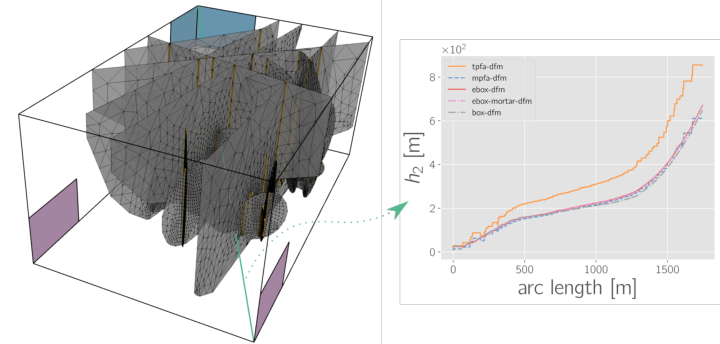Publications
Data sets published by project BX1 can be found on the DaRUS website
Publications in scientific journals
(Journal-) Articles
- Berre, I., Boon, W. M., Flemisch, B., Fumagalli, A., Gläser, D., Keilegavlen, E., Scotti, A., Stefansson, I., Tatomir, A., Brenner, K., Burbulla, S., Devloo, P., Duran, O., Favino, M., Hennicker, J., Lee, I.-H., Lipnikov, K., Masson, R., Mosthaf, K., … Zulian, P. (2021). Verification benchmarks for single-phase flow in three-dimensional fractured porous media. Advances in Water Resources, 147, 103759. https://doi.org/10.1016/j.advwatres.2020.103759
Research
Duration
This project was concluded in FP 1
About this project
The presence of fractures may substantially alter the hydraulic behavior of porous media, which, due to the fact that almost all rocks exhibit fractures, manifests their importance particularly in geotechnical engineering applications. For instance, oil recovery applications or environmental issues as e.g. the integrity of radioactive waste disposal sites are strongly influenced by fractures, while geothermal energy production or unconventional gas production techniques even rely on them. Many of these applications involve complex physics, as not only two-phase flow processes but also non-isothermal effects often play an important role. For example, enhanced geothermal systems using supercritical CO2 as working fluid implicate two-phase flow regimes driven by both the injection as well as buoyancy forces, together with temperature changes caused by heat exchange and by the compression and expansion of CO2.
However, the numerical simulation of fractured porous media is very challenging due to the complex geometries involved in arbitrary networks of fractures, and the typically very small apertures in comparison with the considered spatial scales. These small apertures however often make it possible to approximate the fractures by lower dimensional geometries, which can substantially reduce the computational cost. Following this idea, this project aims at developing finite-volume based hybrid-dimensional models for single- and multi-phase flow through fractured porous media taking into account mechanical deformations.
Results
In the scope of this project, we have developed several finite-volume based schemes
for the simulation of single- and multi-phase flow in fractured porous media.
We have then compared the different schemes in terms of accuracy and computational
efficiency on a number of synthetic test cases as well as benchmark cases from
the literature. Furthermore, we have participated
in the benchmark study "Verification benchmarks for single-phase flow in
three-dimensional fractured porous media" (doi.org/10.1016/j.advwatres.2020.103759).
The figure below shows the setup of one of the benchmark cases defined therein,
together with a plot of the hydraulic head as computed with the different numerical
schemes.

Furthermore, we have extended the models to include the description of the
mechanical deformations of the bulk porous medium, taking into account their
feedback on the hydraulic properties of the fractures. The animation below shows
a synthetic core sample experiment, in which hydrogen is injected at the bottom,
while the top boundary constitutes the outlet. The pressure gradient induced by
the injection leads to deformations of the porous medium, especially around the
fractures, which furthermore act as preferential flowpaths for hydrogen. Note
that the deformations are highly exaggerated for visualization purposes.
Animation of synthetic core sample experiment
Animation of synthetic core sample deformation experiment, in which hydrogen is injected at the bottom, while the top boundary constitutes the outlet.
Future work
With the developed numerical model we would like to contribute to research
related to underground radioactive waste storage. One important question is how and to
what extent fractures present in the surroundings of the waste emplacement
tunnels affect the hydraulic properties of the rock. In particular, an ongoing
debate is about the importance fracture dilation processes. Significant experimental
efforts, both in-situ as well as on core samples in the lab, currently target at
investigating the amount of dilation that is expected to occur. With the numerical
model underlying the above animation, we want to support the experimentalists
in the interpretation of the experimental results.


